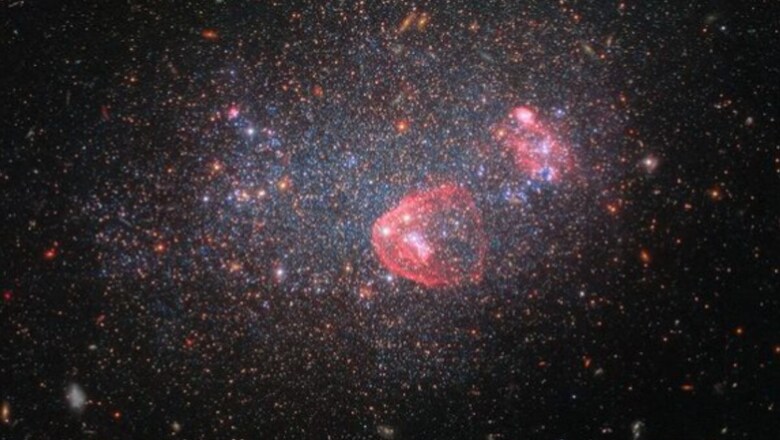
views
The National Aeronautics and Space Administration (NASA) has a range of telescope cameras and satellite cameras that routinely capture planets, cosmos, and galaxies in the universe. Over the years, NASA’s Hubble Space Telescope, named after astronomer Edwin Hubble, has managed to take highly detailed and vibrant photos of galaxies floating in the endless universe. The Hubble Space Telescope is the size of a school bus and it weighs as much as two elephants. It is powered by two 25-foot-long solar panels. Here are three stunning photos that the telescope’s camera managed to take in the past year.
The Irregular Galaxy
Back in December, NASA posted a photo of the ‘Irregular Galaxy’ on Instagram. The photo captured red, blue, and yellow patches of light in the galaxy that was located seven million light years away from Earth.
A post shared by NASA (@nasa)
In the caption, the space research agency wrote, “It’s considered an irregular galaxy because of its unorderly shape which resembles a space version of a sparkly snow globe.” This photo captured 3.9 lakh likes. Commenting on it, an Instagram user wrote, “Wow this is insane what the universe creates.”
Sombrero Galaxy
NASA shared a photo of the spiral-shaped Sombrero galaxy that is located on the “southern edge of the galaxy-rich Virgo cluster”. The Sombrero galaxy is at a distance of 28 million light-years from Earth. It is around half the size of the Milky Way galaxy. This spellbinding photo of the Sombrero galaxy was taken by the Hubble Space Telescope and the Spitzer Space Telescope.
A post shared by NASA (@nasa)
In the caption, NASA explained, “Hubble captured the galaxy in visible light, while Spitzer viewed it in infrared in four different microns: blue, green, orange, and red.” This post has 7.9 lakh likes.
Jellyfish Galaxy
In March 2023, NASA posted a photo of the JW100 galaxy also known as the ‘Jellyfish’ galaxy. It is called the Jellyfish Galaxy because it “resembles a jellyfish with its tentacles dangling in shades of yellow, blue, and green.” The space research agency explained, “the longer tentacles of this galaxy are caused by a process called ram pressure stripping, it occurs when galaxies collide with loose gases which are common in galaxy clusters.”
A post shared by NASA (@nasa)
Hubble Space Telescope’s Wide Field Camera 3 took a picture of the Jellyfish Galaxy on March 20 last year, it was shared on Instagram seven days later, where it got over 10 lakh likes.
What's your reaction?
















Comments
0 comment